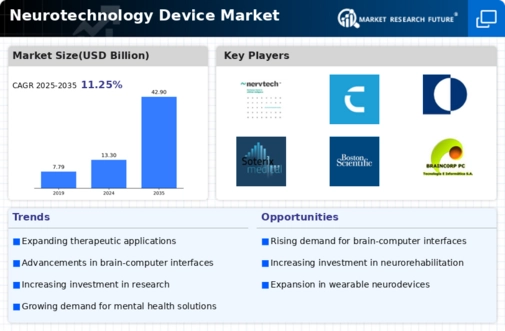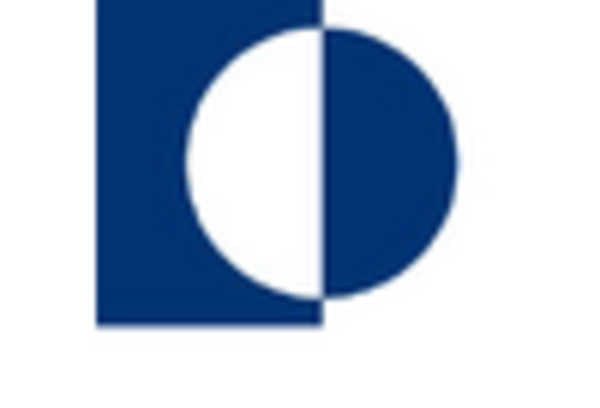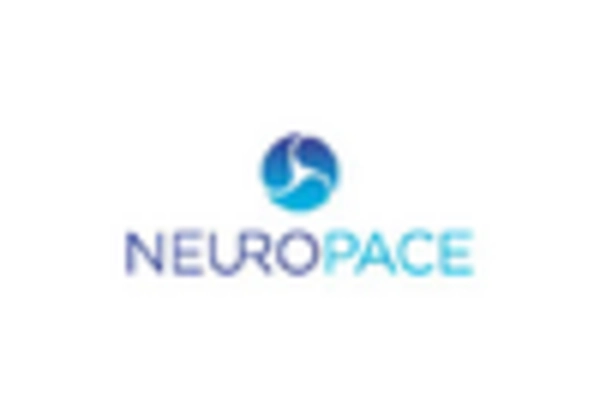Regulatory Support and Frameworks
The establishment of supportive regulatory frameworks is fostering growth in the Neurotechnology Device Market. Regulatory bodies are increasingly recognizing the potential of neurotechnology and are working to create guidelines that facilitate innovation while ensuring safety and efficacy. This proactive approach is likely to encourage manufacturers to invest in the development of new devices, knowing that there is a clear pathway for approval. As regulations evolve to accommodate the unique challenges posed by neurotechnology, the market is expected to expand, with more products entering the marketplace. This regulatory support not only enhances consumer confidence but also stimulates competition, ultimately benefiting the Neurotechnology Device Market.
Growing Investment in Neuroscience Research
The surge in funding for neuroscience research is significantly influencing the Neurotechnology Device Market. Governments and private entities are increasingly recognizing the importance of understanding brain function and its implications for health. This influx of investment is facilitating the development of innovative neurotechnology devices aimed at diagnosing and treating various neurological conditions. In recent years, funding for neuroscience research has seen an upward trend, with billions allocated to projects that explore brain health and neurotechnology applications. This financial support is expected to catalyze breakthroughs in the Neurotechnology Device Market, leading to the introduction of novel devices that could transform patient care and enhance therapeutic outcomes.
Rising Prevalence of Neurological Disorders
The increasing incidence of neurological disorders such as Alzheimer's disease, Parkinson's disease, and epilepsy is a primary driver of the Neurotechnology Device Market. According to recent estimates, the number of individuals affected by these conditions is projected to rise significantly, leading to a heightened demand for innovative neurotechnology solutions. This surge in prevalence necessitates advanced diagnostic and therapeutic devices, thereby propelling market growth. The Neurotechnology Device Market is expected to witness substantial investments aimed at developing cutting-edge technologies that can effectively address these disorders. As healthcare systems strive to improve patient outcomes, the integration of neurotechnology devices into treatment protocols becomes increasingly vital, suggesting a robust future for this sector.
Technological Advancements in Neurotechnology
Rapid advancements in neurotechnology, particularly in areas such as brain-computer interfaces and neurostimulation devices, are driving the Neurotechnology Device Market. Innovations in materials science, signal processing, and machine learning are enabling the development of more effective and user-friendly devices. For instance, the introduction of non-invasive neurostimulation techniques has expanded the potential applications of neurotechnology beyond traditional medical uses. The market is projected to grow at a compound annual growth rate of over 12% in the coming years, reflecting the increasing adoption of these technologies. As research continues to unveil new possibilities, the Neurotechnology Device Market is likely to evolve, offering enhanced solutions for both clinical and consumer applications.
Increasing Awareness and Acceptance of Neurotechnology
As public awareness of neurotechnology grows, so does the acceptance of its applications in healthcare and beyond. Educational initiatives and media coverage are playing a crucial role in demystifying neurotechnology, leading to a more informed consumer base. This shift in perception is likely to drive demand for neurotechnology devices, as individuals become more open to utilizing these innovations for health management. The Neurotechnology Device Market is poised to benefit from this trend, as increased acceptance may lead to higher adoption rates among healthcare providers and patients alike. Furthermore, as more success stories emerge, the market could see a ripple effect, encouraging further investment and development in neurotechnology solutions.


















Leave a Comment